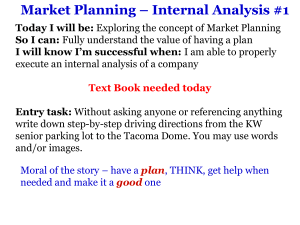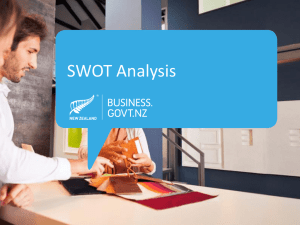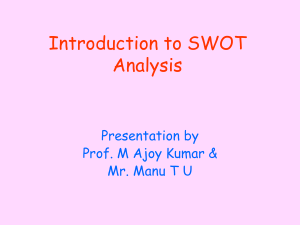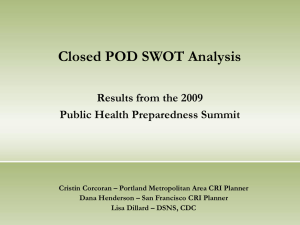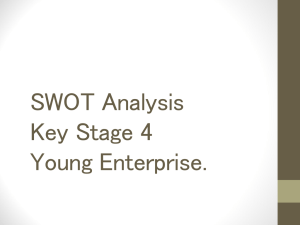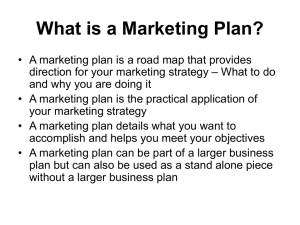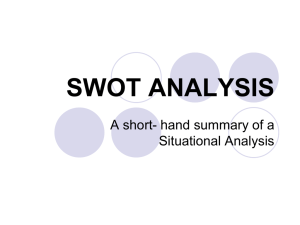Conducting A SWOT Analysis
advertisement
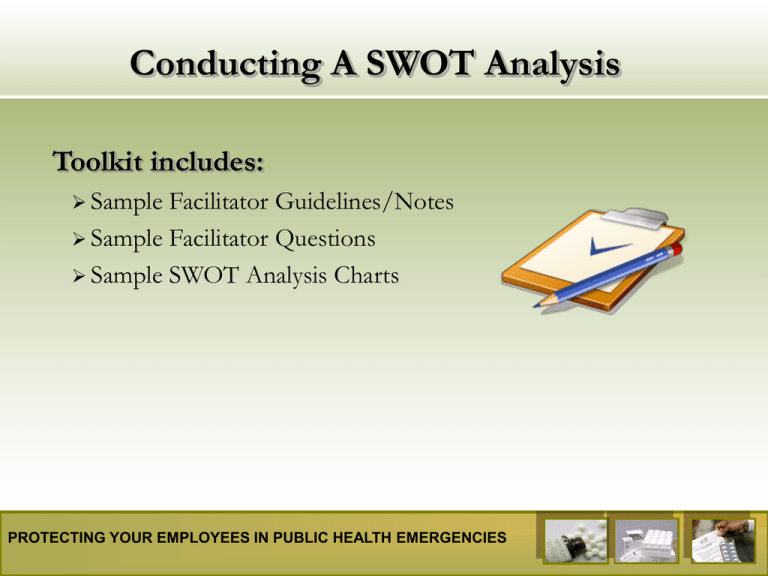
Conducting A SWOT Analysis Toolkit includes: Sample Facilitator Guidelines/Notes Sample Facilitator Questions Sample SWOT Analysis Charts PROTECTING YOUR EMPLOYEES IN PUBLIC HEALTH EMERGENCIES Conducting A SWOT Analysis Facilitator Guidelines/Notes Suggested Supplies Tables & Chairs – sufficient quantities to support break out groups SWOT Analysis Charts/Display boards – – charts and display boards should be large enough to be seen by all participants to capture the results of the analysis – sample charts included in this presentation Writing Supplies – paper, pens, post-it notes Timekeeping mechanism PROTECTING YOUR EMPLOYEES IN PUBLIC HEALTH EMERGENCIES Conducting A SWOT Analysis Facilitator Guidelines/Notes State Objectives & Explain the Process Inform participants of the objective of the SWOT Analysis. In this scenario, participants are discussing how to enhance Closed POD recruiting and technical assistance by understanding commonalities and differences in various organizations. 2 Organize Participants Recommend smaller groups, no more than 10 per group. Groups should designate a spokesperson. In addition to the lead facilitator, consider having co-facilitators assigned to each group to encourage discussion and keep participants on task. 3 Ask Leading Questions Sample questions are provided. Tailor accordingly but ensure they prompt discussion and support the objective. 4 Establish Time Limits for Brainstorming Each Section Recommend 5-8 minutes per section. Do not allow time for participants to justify their response, just capture the response with a short phrase. Justification/analysis will come later in the process. Regroup & Respond Once all areas of the SWOT have been addressed, regroup to discuss the responses. Address each category of the SWOT (Strengths, Weaknesses, Opportunities, Threats) separately. Each group should be prepared to provide the top 2-3 responses for their sector in each area of the SWOT. Do not elaborate on the responses at this point. 1 5 PROTECTING YOUR EMPLOYEES IN PUBLIC HEALTH EMERGENCIES Conducting A SWOT Analysis Facilitator Guidelines/Notes 5 Regroup & Respond 6 Discussion & Analysis: Exploit strengths & opportunities; mitigate weaknesses and threats 7 Conclude Session Lead facilitator considers the responses and determines where they fit on the supporting charts: • Strengths and Weaknesses should be internal to the organization. • Opportunities and Threats should be external to the organization. • If more than two groups provide the same response, add it to the “commonalities” chart. • If only one group provides a certain response, add it to that particular sector’s chart. Facilitators should encourage discussion that helps participants develop suggestions for using the strengths and opportunities to their advantage and developing strategies to overcome the challenges presented through the weaknesses and threats. Participants can use applicable information to tailor recruiting strategies and messages; and refine technical assistance methods when working with various Closed POD organizations. PROTECTING YOUR EMPLOYEES IN PUBLIC HEALTH EMERGENCIES Conducting A SWOT Analysis Closed POD Planning Sample Facilitator Questions PROTECTING YOUR EMPLOYEES IN PUBLIC HEALTH EMERGENCIES Conducting A SWOT Analysis Sample Facilitator Questions Strengths: 1) What advantages does your public health agency have that would impact 2) 3) 4) 5) 6) 7) an organization’s decision to become a Closed POD? What advantages does this sector have in being a Closed POD? What do you do better than anyone else? What do they do better than anyone else? What unique resources* do you have access to? What unique resources* do they have access to? What are the advantages of Closed POD program? * Examples of Resources = assets, skills, experiences, processes, people, funding, data PROTECTING YOUR EMPLOYEES IN PUBLIC HEALTH EMERGENCIES Conducting A SWOT Analysis Sample Facilitator Questions Weaknesses: 1) What disadvantages does your public health agency have that would 2) 3) 4) 5) 6) impact an organization’s decision to become a Closed POD? What real or perceived reasons could there be for not using this sector as a Closed POD? What real or perceived reasons could impact this sector’s decision to become a Closed POD? What resources* are you lacking? What resources* are they lacking? What are the disadvantages of the Closed POD program? * Example of Resources = assets, skills, experiences, processes, people, funding, data PROTECTING YOUR EMPLOYEES IN PUBLIC HEALTH EMERGENCIES Conducting A SWOT Analysis Sample Facilitator Questions Opportunities: 1) What interesting external trends are you aware of that may impact Closed POD planning? 2) What changes are occurring or are needed in your jurisdiction to support the program or participation in the program? Consider the following: • Technology • Legislation • Socio-cultural 3) How can you capitalize on previous relationships that may be established between other programs in your health department and organizations within the various sectors? PROTECTING YOUR EMPLOYEES IN PUBLIC HEALTH EMERGENCIES Conducting A SWOT Analysis Sample Facilitator Questions Threats: 1) What external factors are you aware of that may impact your ability to recruit or provide technical assistance Closed PODs? 2) What external factors are you aware of that may impact your ability to incorporate or manage the operations of Closed PODs in your dispensing strategy during an emergency? 3) Are you aware of partnerships between your health department and organizations within the sectors that may have produced poor outcomes that may impact your ability to form a partnership? 4) Are you aware of a lack of strong leadership or support from political leaders, preparedness partners, or other influencing agencies? PROTECTING YOUR EMPLOYEES IN PUBLIC HEALTH EMERGENCIES Conducting A SWOT Analysis Closed POD Planning Sample Charts (pick best for you) PROTECTING YOUR EMPLOYEES IN PUBLIC HEALTH EMERGENCIES Strengths: Weaknesses: Opportunities: Threats: Strengths: Weaknesses: Opportunities: Threats: Strengths: Weaknesses: Opportunities: Threats: Strengths: Weaknesses: Opportunities: Threats: Strengths: Weaknesses: Opportunities: Threats: Strengths: Weaknesses: Opportunities: Threats: Contact Information Name: Contact Info If you are comfortable with it, please share the results of your SWOT Analysis: ppr@crinorthwest.org PROTECTING YOUR EMPLOYEES IN PUBLIC HEALTH EMERGENCIES

